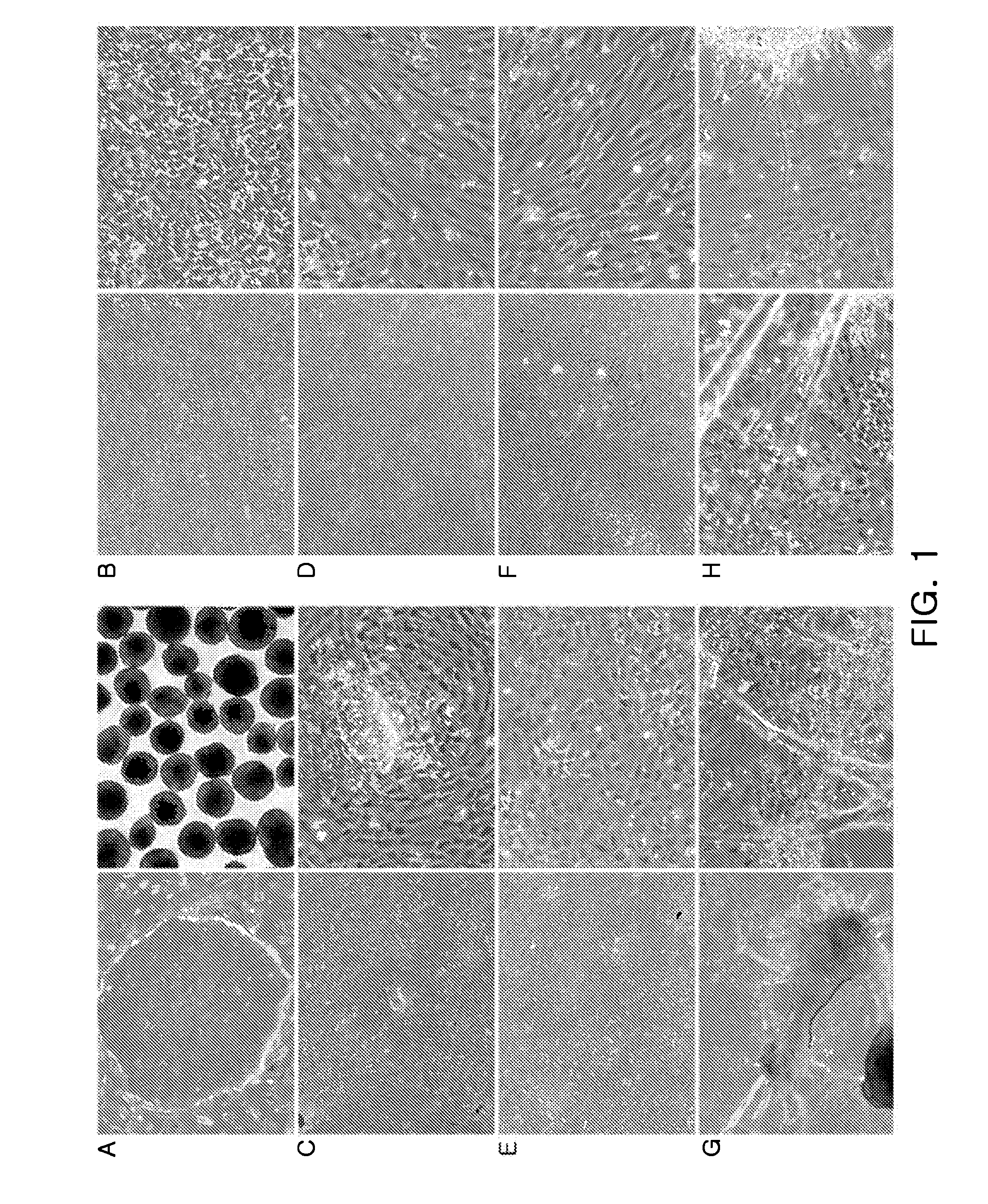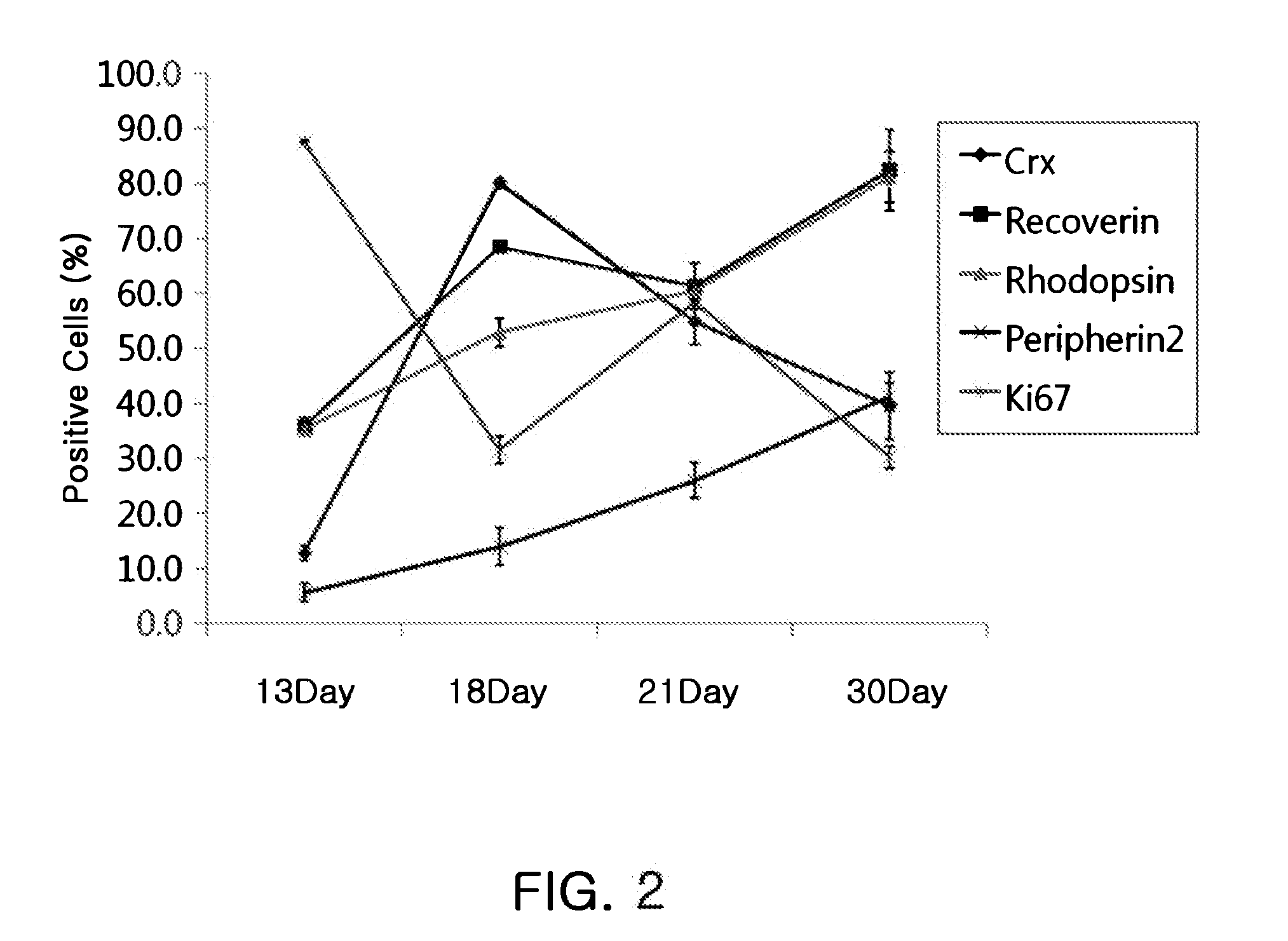Compositions for inducing differentiation into retinal cells from retinal progenitor cells or inducing proliferation of retinal cells comprising wnt signaling pathway activators
a technology of progenitor cells and retinal cells, which is applied in the direction of cell culture active agents, embryonic cells, artificial cell constructs, etc., can solve the problems of failure in most cases, no drugs have been developed for the fundamental treatment of these diseases, and suffer from great losses in personal, social and economic aspects, etc., to achieve high yield, easy transplantation into degenerated or injured retinas, and high yield
- Summary
- Abstract
- Description
- Claims
- Application Information
AI Technical Summary
Benefits of technology
Problems solved by technology
Method used
Image
Examples
example 1
Culture of Stem Cells
Culture of Human Embryonic Stem Cells
[0192]The human embryonic stem cell (hESC) lines H9 (WA09, normal karyotype XX) and H7 (WA07, normal karyotype, XX) were purchased from the WiCell Research Institute (Madison, Wis., USA).
[0193]The hESCs were allowed to proliferate undifferentiated (H9 cells: passages 25˜33; H7 cells: passages 23˜28) by culturing over feeder cells, such as radiated mouse embryonic fibroblasts (MEF, ATCC, Manassas, Va., USA) or mitomycin-treated mouse embryonic fibroblasts (EmbryoMax Primary Mouse Embryo Fibroblasts, Millipore, Billerica, Mass., USA) in the following medium: DMEM / F12 (Invitrogen, Grand Island, N.Y., USA), 20% (v / v) KnockOut serum replacement, Invitrogen, Carlsbad, Calif., USA), 1 mM L-glutamine (Invitrogen), 0.1 mM nonessential amino acids (Invitrogen), 0.1 mM mercaptoethanol (Sigma-Aldrich, St. Louis, Mo., USA), and 4 ng / ml human recombinant basic fibroblast growth factor (FGF2, Invitrogen).
[0194]While the medium was replaced...
example 2
Differentiation from hESCs or Human iPSCs into Eye Field Precursors
[0200]The hESCs or human iPSCs cultured in Example 1 were separated from the MEF cells (FIGS. 1 and 14) and seeded into 6-well ultra-low attachment plates (Corning Incorporated, Corning, N.Y., USA).
[0201]To the hESCs or human iPSCs in the 6-well ultra-low attachment plates was added a medium for inducing differentiation into eye field precursors [DMEM / F12, 10% KnockOut serum replacement, 1 mM L-glutamine, 0.1 mM nonessential amino acids, 0.1 mM mercaptoethanol, 1% B27 supplement (Invitrogen), 1 ng / ml recombinant noggin (R&D Systems), 1 ng / ml recombinant Dkk-1 (Dickkopf-1, R&D Systems), and 5 ng / ml recombinant IGF-1 (insulin-like growth factor-1, R&D Systems)]. The cells were cultured for 4-5 days to generate eye field precursors in the form of floating aggregates with the replacement of the medium with a fresh one every third day (FIG. 1).
example 3
Differentiation from Eye Field Precursors into Retinal Progenitor Cells
[0202]The eye field precursors (floating aggregates) generated in Example 2 were seeded at a density of 53±8 cells per well (292±53 cells / floating aggregate) into 6-well poly-D-lysine / laminin-coated plates (BD Biosciences) and at a density of 12±4 cells per well on 8-well poly-D-lysine / laminin-coated plates and then cultured for 9 days to generate retinal progenitor cells, with the supply of a medium for inducing differentiation into retinal progenitor cells [DMEM / F12 (Invitrogen), 1 mM L-glutamine (Invitrogen), 0.1 mM nonessential amino acids (Invitrogen), 0.1 mM mercaptoethanol (Sigma-Aldrich), 1% B27 supplement, 1% N2 supplement (Invitrogen), 10 ng / ml Dkk-1, 10 ng / ml noggin, 10 ng / ml IGF-1, and 5 ng / ml FGF2].
PUM
| Property | Measurement | Unit |
|---|---|---|
| concentration | aaaaa | aaaaa |
| concentration | aaaaa | aaaaa |
| concentration | aaaaa | aaaaa |
Abstract
Description
Claims
Application Information
 Login to View More
Login to View More - R&D
- Intellectual Property
- Life Sciences
- Materials
- Tech Scout
- Unparalleled Data Quality
- Higher Quality Content
- 60% Fewer Hallucinations
Browse by: Latest US Patents, China's latest patents, Technical Efficacy Thesaurus, Application Domain, Technology Topic, Popular Technical Reports.
© 2025 PatSnap. All rights reserved.Legal|Privacy policy|Modern Slavery Act Transparency Statement|Sitemap|About US| Contact US: help@patsnap.com



